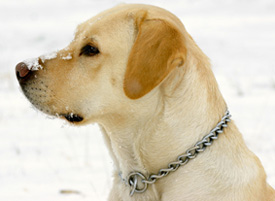Keep Your Pet Warm This Winter
Cold weather can be hard on pets, just like it can be hard on people. Sometimes owners forget that their pets are just as accustomed to the warm shelter of the indoors as they are. Some owners will leave their animals outside for extended periods of time, thinking that all animals are adapted to live outdoors. These are the most popular petfriendly products.
 This can put their pets in danger of serious illness. There are things you can do to keep your animal warm and safe.
This can put their pets in danger of serious illness. There are things you can do to keep your animal warm and safe.
- Take your animals for a winter check-up before winter kicks in.
- Keep your pets inside as much as you can when the mercury drops. If you have to take them out, stay outside with them. When you’re cold enough to go inside, they probably are too.
- If you absolutely must leave them outside for a significant length of time, make sure they have a warm, solid shelter against the wind, thick bedding, and plenty of non-frozen water. Try leaving out a hot water bottle, wrapped in a towel so it won’t burn your pet’s skin. Some animals can remain outside safely longer in the winter than others.
- In some cases, it’s just common sense: long-haired breeds like Huskies will do better in cold weather than short-haired breeds like Dachshunds. Cats and small dogs that have to wade shoulder-deep in the snow will feel the cold sooner than larger animals. Your pet’s health will also affect how long she can stay out.
- Animals that are not generally in good health shouldn’t be exposed to winter weather for a long period of time. Conditions like diabetes, heart disease, kidney disease, and hormonal imbalances can compromise a pet’s ability to regulate her own body heat.. Very young and very old animals are vulnerable to the cold as well.
- No pets should stay outside for unlimited amounts of time in freezing cold weather. If you have any questions about how long your pet should be out this winter, ask your veterinarian.
- If you live near a pond or lake, be very cautious about letting your rambunctious dog off the leash. Animals can easily fall through the ice, and it is very difficult for them to escape on their own. If you must let your dogs loose near open water, stay with them at all times.
- Cats will curl up against almost anything to stay warm–including car engines. Before you turn your engine on, check beneath the car or make a lot of noise by honking the horn or rapping on the hood.
- If you light a fire or plug in a space heater to keep your home toasty warm, remember that the heat will be as attractive to your pets as to you. As your dog or cat snuggles up to the warmth, keep an eye out to make sure that no tails or paws come in contact with flames, heating coils, or hot surfaces. Pets can either burn themselves or knock a heat source over and put the entire household in danger.
- It’s a good idea to have your furnace checked for carbon monoxide leakage before you turn it on, both for your pets’ health and your own. Carbon monoxide is odorless and invisible, but it can cause problems ranging from headaches and fatigue to trouble breathing. Pets generally spend more time in the home than owners, particularly in the winter, so they are more vulnerable to carbon monoxide poisoning than the rest of the family.
- Pets that go outside can pick up rock salt, ice, and chemical ice melts in their foot pads. To keep your pet’s pads from getting chapped and raw, wipe her feet with a washcloth when she comes inside. This will also keep her from licking the salt off her feet, which could cause an inflammation of her digestive tract. If left alone outside, dogs and cats can be very resourceful in their search for warm shelter.
- Provide them with quality, easily accessible shelter. They can dig into snow banks or hide under porches or in dumpsters, window wells, or cellars, and they can occasionally get trapped. Watch them closely when they are loose outdoors, and Keep an eye on your pet’s water.
- Sometimes owners don’t realize that a water bowl has frozen and their pet can’t get anything to drink. Animals that don’t have access to clean, unfrozen water are more likely to drink out of puddles or gutters, which can be polluted with oil, antifreeze, household cleaners, and other chemicals.
- Be particularly gentle with elderly and arthritic pets during the winter. The cold can leave their joints extremely stiff and tender, and they may become more awkward than usual. Stay directly below these pets when they are climbing stairs or jumping onto furniture; consider modifying their environment to make it easier for them to get around. Make sure they have a thick, soft bed in a warm room for the chilly nights. Also, watch stiff and arthritic pets if you walk them outside; a bad slip on the ice could be very painful and cause a significant injury. Pets lose most of their body heat from the pads of their feet, their ears, and their respiratory tract. The best way to guard your animals against the cold is keeping a close eye on them to make sure they’re comfortable. When you’re outside with your pets during the winter, you can watch them for signs of discomfort with the cold. If they whine, shiver, seem anxious, slow down or stop moving, or start to look for warm places to burrow, they’re saying they want to get back someplace warm.
- You can also keep an eye out for two serious conditions caused by cold weather.







